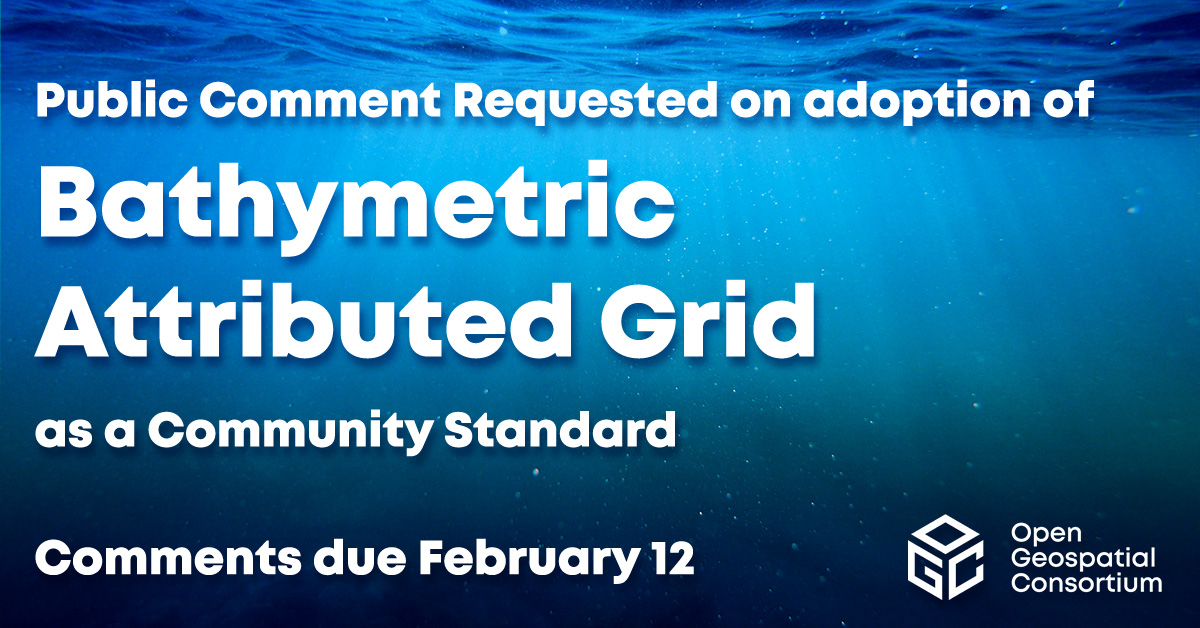Request Closed: January 22, 2024 9:00 am — February 12, 2024 11:59 pm (AoE)
The Open Geospatial Consortium (OGC) seeks public comment on the potential adoption of the Bathymetric Attributed Grid (BAG) as an OGC Community Standard. Comments are due by February 12, 2024.
BAG is an open specification for representing bathymetric data as regular grids of seafloor depths with the corresponding vertical uncertainty and associated metadata. The BAG specification has been in use for conveying and archiving bathymetry, uncertainty, and metadata by a number of Hydrographic Offices for close to 20 years, including by U.S. National Oceanic and Atmospheric Administration (NOAA) Office of Coast Survey, the US Naval Oceanographic Office, the UK Hydrographic Office (UKHO), and many others. The format is also used by academic partners around the world. BAG files have support in several major GIS packages, and hydrographic processing applications.
BAGs are a realization of the well-defined Navigation Surface concept. The design of the Navigation Surface concept envisioned a new structure for hydrographic product creation from basic surveys. Relying on a database to hold all the original data, processed into the form of grids of the best available representation of the true nature of the seafloor, the Navigation Surface concept allows for the extraction of whatever data are required for a particular product and, through automatic manipulation and/or cartography, enables the hydrographer to construct a product suitable for a particular purpose.
Depending on the task at hand, this might be a uniform grid at the best available resolution (e.g., for flow modeling), or a hydrographic vector-based chart for safety of navigation. To make this possible, the database must contain the best available data for each area, at the highest achievable resolution, and may contain data from a number of different sources, potentially from a number of different software packages.
To realize such a database, there is a need for a uniform file format that allows data to be passed between software packages, and between agencies involved in the collection, processing and dissemination of the data, while maintaining the integrity of the data and metadata at all times. The file format should also be sufficiently flexible to support processing of data without format conversion where possible, since format conversion can be an extremely expensive process. The Open Navigation Surface (ONS) Project has as its mandate the task of building such a data file format: the Bathymetric Attributed Grid (BAG).
BAG use in various applications is rarely feature-complete, with each focusing on specific features needed in each context. Further, varying expectations on the use-cases for the BAG format can make interoperability a struggle. The adoption of BAG as an OGC Community Standard would help resolve these issues and improve the accessibility, interoperability, and reuse of bathymetry data.
The work item justification for the adoption of the Bathymetric Attributed Grid (BAG) as an OGC Community Standard (#24-000) (.HTML) is available for review and comment on the OGC Portal. Comments are due by February 12, 2024, and should be submitted via the method below.
To Comment:
Comments can be submitted to a dedicated email reflector for a period ending on the “Close request date” listed above. Comments received will be consolidated and reviewed by OGC members for incorporation into the document. Please submit your comments via this email address, using this Comments Template for the message body.
Subscribe to Comments:
You may wish to subscribe to the distribution list to receive comments as they are submitted. Subscribing to the list will also allow you to view comments already received, which can be found in the List Archives.
